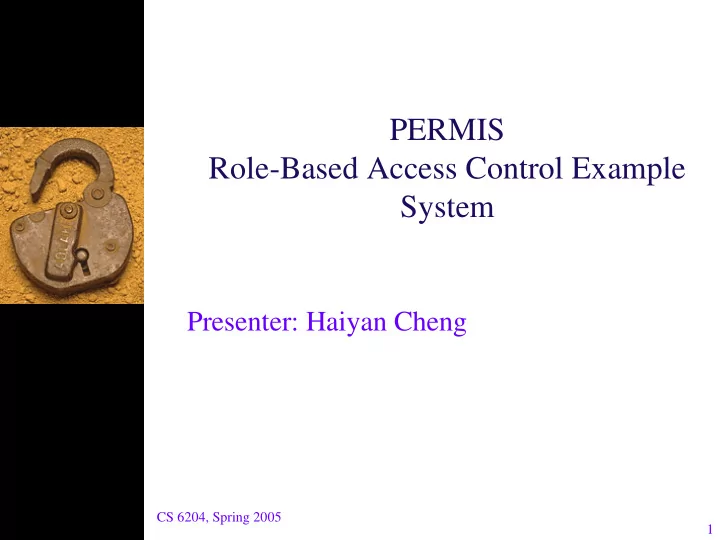

PERMIS Role-Based Access Control Example System Presenter: Haiyan Cheng CS 6204, Spring 2005 1
PERMIS Review ♦ A role-based access control infrastructure ♦ Uses X.509 attribute certificate (AC) to store user’s roles ♦ All access control decisions are driven by authorization policy ♦ Policies are stored in AC ♦ ACs are stored in one or more LDAP directories ♦ Authorization Policies are written in XML ♦ ADF(Access Control Decision Function) is written in Java & Java API ♦ Include a Privilege Allocator – Construct AC – Sign AC – Stores AC in LDAP CS 6204, Spring 2005 2
Comparison of PKI and PMI Authentication Authorization Is used for Is used for PKI PMI Binds Binds User’s name Public Key User’s name Privilege Attribute Sign Sign ACRL CRL CA AA issues issues Subordinate AA Subordinate CA Root CA Source of Authority CS 6204, Spring 2005 3
Possible Authorization Schemes ♦ Discretionary Access Control (DAC) ♦ Multilevel Secure (MLS) system, a type of Mandatory Access Control (MAC) ♦ Role-Based Access Control (RBAC) – Basic – Hierarchical—involves privilege inheritance – Constrained RBAC—allow constraints to be applied to the roles and permissions • Mutually exclusive role • No. of roles one can hold • No. of people who can hold a particular role • Time constraint—validity period for RBAC CS 6204, Spring 2005 4
PERMIS PMI Architecture ♦ Privilege Allocation Subsystem – Responsible for allocating privilege to the users ♦ Privilege Verification Subsystem – Responsible for authenticating (application specific) and authorizing (application independent) users CS 6204, Spring 2005 5
6 The Privilege Allocation Subsystem From PERMIS paper CS 6204, Spring 2005
The Structure of the Policy DTD ♦ SubjectPolicy – specifies subject domain ♦ RoleHierarchyPolicy – specify the different roles and hierarchy relations ♦ SOAPolicy – specify which SOAs are trusted to allocate roles, and permits the distributed managements of roles to take place ♦ RoleAssignmentPolicy – specify which role maybe allocated to which subject by which SOA, weather delegation of roles may ake place or not, and how long the roles maybe assigned for ♦ TargetPolicy – specify target domain covered by the policy ♦ ActionPolicy – specify actions supported by the target and parameter needed for each action ♦ TargetAccssPolicy – specify which roles have permission to perform which actions on which target and under which conditions. CS 6204, Spring 2005 7
8 The Privilege Verification Subsystem From PERMIS paper CS 6204, Spring 2005
Recommend
More recommend